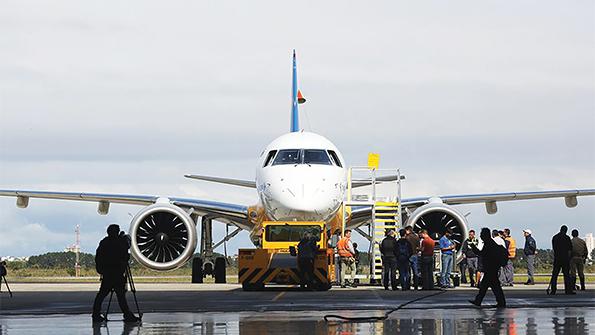
As the MRO market looks to recover post-COVID-19, it is widely acknowledged that smaller-capacity aircraft will drive any revival. Naturally, this discussion often centers on Boeing 737 and Airbus A320 models. As a result, the market resilience of the Embraer E-Jet family of aircraft is sometimes overlooked in the context of the narrowbody segment’s recovery.
Aviation Week’s Fleet & MRO Forecast indicates the Brazilian-made aircraft’s bullish prospects, which paint a picture of stability. In 2021, 1,431 of the aircraft family are in service, a number that is expected to grow slightly, to 1,583, by the end of the decade in 2030. This increase will be driven by the continued entry into service of the E-Jet E2 family. The first E190-E2 began operations in 2018. While there are fewer than 50 of the newer aircraft family in-service this year, -E2s are expected to number nearly 450 by the end of the decade and comprise slightly less than one-third of the overall fleet.
The gradual recovery of commercial aviation in North America, further bolstered by the accelerated vaccine rollout in the U.S., has been positive for the market and in turn for aircraft like the E-Jets. North America is the largest global region for the E-Jet, with approximately 645 in operation this year, according to Aviation Week data. Republic Airways and SkyWest Airlines are North America’s largest E-Jet operators.
The aftermarket related to the aircraft is projected to remain at current levels and not see much in the way of 10-year growth. However, this has not stopped some MROs providers from expanding their reach in areas such as the parts market in recent years. MRO providers such as Spairliners have added more E-Jet component agreements, while GA Telesis’ MRO Services moved into landing-gear repairs in 2019. That same year, AerFin expanded its regional scope for the aircraft in North America. The company set up a parts storage and distribution facility in Atlanta focusing on the E-Jet.
Embraer itself remains buoyant about the aircraft’s recovery prospects in a post-COVID world as airlines adjust their fleets. Speaking during an Aviation Week webinar about OEMs in the aftermarket in April, Alexandre Avila, vice president of strategy, programs and innovation at Embraer Services & Support, said that while caution remains, he believes the E-Jet could recover faster than some other aircraft programs.
The proposed (but now terminated) joint venture with Boeing in April 2020, a 80%-20% partnership, would have seen the mooted company of Boeing Brasil take charge of the E-Jet program. Given the partnership would have also encompassed maintenance services, it would have heavily affected the aftermarket network for the aircraft. Since then, Embraer has integrated commercial maintenance into its services and support division and is looking for further ways to explore revenue diversification. “We are recovering a lot of synergies and we plan to maintain focus on the business growth of Embraer,” Avila says.
Avila used the example of its Portugal-based OGMA subsidiary, which earlier this year became an authorized repair provider for the Pratt & Whitney PW1100G engine powering the second-generation E-Jets. The surging cargo market is also being explored, with some ERJ 145s being modified for freight. While there is no E-Jet converted freighter aircraft, speculation in late 2020 suggested that Embraer was exploring the possibility of a secondary market for older E-Jets to operate as cargo aircraft.
At the height of the COVID-19 crisis, as flying restrictions took hold, many E-Jets were placed into storage, they will not manifest themselves necessarily in the form of retirements even though roughly half the fleet is 10 years old or more. Inevitably, it is the oldest E170 variant that will leave the global fleet the fastest. Retirement forecasts by Aviation Week show E170 and E175 aircraft are set to be retired in greater volumes from 2025 onward.
Post-crisis, there could be conditions that would encourage more leasing of E-Jets. Sergii Grytsenko, fleet contracts director at Ukraine International Airlines, which operates five E-Jets, says leasing terms and options for the aircraft have become more favorable because of the crisis. “Two years ago it was a problem to find good aircraft on lease but nowadays we don’t have this problem,” he says. “It is now relatively easy to get aircraft such as the E190 in any age or delivery condition we want.”
This also applies to the aircraft’s GE CF34 engines, with both the aircraft and engine type remaining an attractive green-time option, Grytsenko says. Ukraine International will postpone fleet modernization plans for the next five years, as Grytsenko says the carrier prefers to extract value from its now- reduced fleet, which also includes Boeing 737s, 767s and 777s.
Aviation Week estimates about 57% of E-Jet maintenance work in 2021 will come from engines, despite some operators moving to postpone shop visits as a cost-saving measure. The lion’s share of MRO spending will emanate from the established CF34 engine and its -8E and -10E variants, which combined will account for around $1.1 billion in MRO spending.
Embraer E-Jet in Numbers
$37.0 Billion 10-year MRO spending, 2021-30
1.1% Overall CAGR fleet growth rate, 2021-30
6.04% Fleet growth in Africa (the highest by region expected over the next 10 years)
221 Number of aircraft operated by Republic Airways, the world’s largest E-Jet operator
237 Number of newer E190-E2s expected to be in service in 2030

